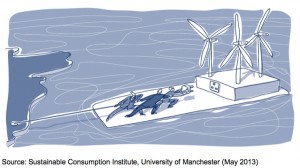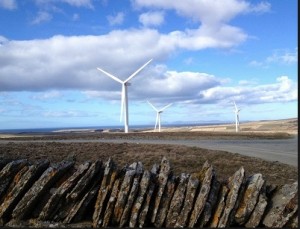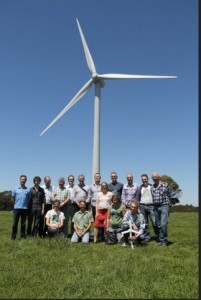Background
What’s remarkable about the recent report, National Wind Energy in Ireland: Building Community Engagement and Social Support, by the National Economic and Social Council (NESC), is that it has to argue strenuously that the Irish government needs to engage with the public-at-large on an issue and policy as critical as renewable energy. At one point, the NESC emphatically states that “Irish communities have not been afforded the opportunities for energy development that communities elsewhere are being offered. The contrast with the rest of Europe is striking.” At 35. Who is not affording these opportunities? The NESC does not name the culprit, but it is the Irish government, of course. The NESC advises the Taoiseach on strategic policy issues relating to sustainable economic, social and environmental development in Ireland, so its indirect critique is all the more telling.
As we shall see, the problem with developing wind power in Ireland may have as much to do with the lack of government engagement with the public as with any technological and policy issues.
The main report by NESC is supported by two underlying reports, providing the background, data and analysis, by SLR, global environmental solutions. The report is timed to coincide with the government’s publication of a Green Paper on Energy Policy in Ireland and the public consultation process that accompanied the Green Paper.
The Changing Landscape
Ireland’s transition to a low-carbon economy rests heavily on the wide availability of wind power on and off the island. Until recently, wind energy enjoyed wide-spread support in Ireland with 80% of the public backing the use of wind energy. While this survey (2013) was sponsored by the Irish Wind Energy Association, it confirms a study by Sustainable Energy Ireland, in 2003, which found that “The survey highlights that in total over eight in ten of those questioned are favourable to the construction of more wind farms in Ireland.” [Emphasis added]
 That support seems to be diminishing, rather suddenly. Now there is organised opposition to wind farms in many areas of the countryside, and opponents of wind farms have joined up with opponents of an expansion of the electricity grid with more pylons. The pylon critics claim that the expansion of the grid, and proliferation of pylons across the countryside, is necessitated by the expansion of wind farms.
That support seems to be diminishing, rather suddenly. Now there is organised opposition to wind farms in many areas of the countryside, and opponents of wind farms have joined up with opponents of an expansion of the electricity grid with more pylons. The pylon critics claim that the expansion of the grid, and proliferation of pylons across the countryside, is necessitated by the expansion of wind farms.
Certainly some of this change in attitude can be attributed to the very large scale plans for 40 wind farms with 2,000 turbines, some of the largest in the world, in five counties in the midlands as part of a grand scheme by the Irish government to export renewable energy to the United Kingdom (UK). In effect, the midlands would be dotted or blanketed with wind turbines to provide cheap electricity to homes and businesses in the UK, where people in the countryside and many Conservative politicians reject wind farms. Despite the financial benefits to Irish landowners where turbines would be located, and to the energy companies, the grand scheme was perceived as a plan to destroy the Irish countryside to feed cheap energy to the UK
While the deal for the grand scheme for the midlands fell apart, the Irish government, and all those supporting the development of renewable energy, are now paying the price for the government’s neglecting to adequately or fully engage the Irish public, and especially those communities directly affected by this renewable energy project.
Besides the perceived problem of the midlands project exporting the renewable energy to the UK, there was also the issue that the wind farms were to be developed, owned and exploited by companies or institutions from outside the communities affected.
Currently in Ireland there are 180 wind farms providing 2080 MW of installed capacity from over 1,300 turbines. Yet precious few of these wind farms are owned by communities, or even individuals, but rather most are selected, controlled, and owned by private, state or semi-state companies. In contrast, in Denmark 2,000 of 5,200 turbines are owned by local wind-turbine owners’ associations; in Germany over 50% of renewable-energy projects are owned by individuals and farmers. The Scottish Government estimates that there is already at least 147MW of renewables capacity in community and local ownership, spread across 3,400 sites, and it has set a target of 500 MW community and locally-owned renewable energy by 2020. SLR at 94.
Scotland offers a particularly useful comparison because of its close proximity and cultural connections, and because it is widely viewed as a leader in how it has rolled out large-scale renewables. “Scotland’s success appears to have resulted from a combination of stating renewables targets, a well-developed energy sector, a high degree of policy coherence and consensus amongst business and political elites, plus a clear vision and leadership for the country’s energy future.” SLR at 83.
In light of the current questioning by the public about the benefits of wind energy, the NESC has examined several other countries to learn how they handled the issue of public support for, or opposition to wind farms.
Engaging the Public
The NESC offers three “components” for the government to gather public, or social, support for an energy policy, particularly one based in good part on wind.
First, there has to be a clearly articulated energy policy that comes out of a national discourse with acknowledgement of international best practices. Of course, Ireland has already committed to a low-carbon economy that depends to a great extent on wind energy and energy efficiency. But there are added dimensions to any energy policy that need to be dealt with, including an antiquated grid not suitable for small-scale, intermittent generators (that can include individuals); individual and community-owned energy sources; and, the need for a cross-department government approach to energy policy.
Critically, energy companies, and governments, need to recognize that individual citizens are not just consumers of energy but also producers, generators, and possibly distributors and that they need to be considered in these roles in the implementation of any energy policy. The current Green Paper on Energy Policy involves a public consultation process, but as we see at the end of this report, the experience has been that the government is less than responsive to such consultations. Even NESC suggests that the Green Paper consultation is less than what is needed for real consensus-building for an energy policy. Finally, the NESC report argues that while economic recovery has been a priority, nevertheless a low-carbon economy is key for job creation, energy security and fulfilling environmental obligations.
Second, there must be an inclusive process of public participation, that is real and early and that can actually help shape the energy policy, and that requires some financial support especially at the beginning of the process. Most importantly, the process must be “ fair and genuine” which means, above all else, that the outcome has not been determined in advance, as seems to have been the case with the Harvest 2020 Assessment. See below.
The Danish experience is instructive. The Danish government obligated local municipalities to allocate zones for wind power with mapping before developers are involved, although not all did so; the government established an intermediary body, the Wind Turbine Task Force, that serves municipalities with advice on technical and planning matters, suitable sites, and stakeholder engagement; funding was provided for local associations for early analysis and planning; subsidies were offered for local communities with wind turbines; and compensation was paid for property owners for loss of value because of wind turbines. Compare this approach with the Irish government position, whenever it is determined.
As the NESC notes, “In Ireland, information provision and minimal consultation, as required under the planning process, seems unlikely to be sufficient to gain support for wind projects, now and into the future.” At 41. Interestingly, NESC also suggests that not only is the Irish planning process flawed, as a model for public participation in developing energy policy, but so is the Aarhus Convention — particularly Pillar 2, public participation in decision-making — which to date has been ineffective as applied in Ireland.
Third, to facilitate the public participation, there is an important role for enabling or intermediary actors, including organizations. This is one of the more interesting, and valuable contributions of the NESC report. The report recognizes that successful wind energy projects involve a synthesis between the expertise of the business sector and the needs of local communities, but there is a disconnect between the two, and perhaps a healthy dose of distrust on both sides.
At first the NESC report focuses on public-sector organizations that can serve as intermediaries between the two groups, including two government departments (Communications, Energy and Natural Resources; and Environment, Community and Local Government), the Sustainable Energy Authority of Ireland (SEAI), and Local Authorities. Unfortunately, the first three organizations are either directly or indirectly beholden to the government for funding and direction, and local authorities vary drastically in their expertise and ability to engage with the public. While some local authorities are active in supporting local involvement with renewable energy projects, many are not. In all cases, these actors are not “intermediaries” between the public and the developers, but more often perceived to be, and actually are, on the side of the private developers.
Local communities typically require expert advice to understand the options available in any energy project, including technical and economic dimensions. Communities rarely can match the resources available to the energy companies for such analysis. The experience in Denmark, Germany and Scotland demonstrate the usefulness of truly independent intermediaries that can provide technical expertise, policy and economic experience, and often actual funding to assist communities to understand the process, to engage with the developers, and, if appropriate, to participate in the energy project.
Ireland has had experience with other forms of co-operatives, as in the areas of food production and water management (local water projects), as well as managing commonage where natural resources are shared for the benefit of all members of the commonage, at least in theory. At Templederry, inTipperary, these experiences were applied to the successful development of a co-operative wind farm.
Other Matters
The NESC report offers, in addition to the three “components,” a useful discussion of four structures through which community members can participate in wind energy projects. At 32-26. The options include: (1) community benefits, where the energy developer pays a sum of money, usually fairly modest, to the community for various improvements, typically chosen by the community or local authority; (2) equity involvement, where anyone can invest, even through crowd-funding, in an energy project controlled by developers, although in Denmark developers are required to offer those living close to turbines to purchase up to 20% of the investment needed ; (3) energy co-operatives typically controlled by local communities and/or local authorities, such as in the Aran Islands or Drumlin in Northern Ireland; and, (4) joint ventures, where private individuals, community groups, or local authorities, work together with companies to develop, operate and profit from an energy project. All these options need to be preserved and developed for a successful Irish energy policy.
Conclusion
From its review of the policies and practices of those who have been successful in developing renewable energy across their society, as in Denmark and Germany, the NESC learned that authentic wide-spread engagement with the public is the foundation for that success. That is the message of the report. Whether the government hears that message remains an open question.
Absent litigation or pressure from the EU, Irish governments have evidenced a reluctance to provide environmental assessments that give the public an opportunity to examine an issue and the government’s proposed way of handling that issue, and for the public’s submissions to actually be listened to. For instance, Harvest 2020 is an industry-government joint initiative, to expand farming production and sales, that the government denied was a “policy” since that would trigger a formal environmental assessment. Only after the Friends of the Irish Environment brought the matter to the attention of the European Commission did the Irish government agree to an assessment, which it termed an Appropriate Assessment, something short of an Strategic Environmental Assessment. Then it blithely took the submissions from the public and proceeded to ignore them as the policy remained unchanged, unaffected by the assessment process. See Interview with David Healy. Similarly, despite wide-spread demands from the public for a truly independent climate change advisory committee, in the climate change bill, the government puts forth a committee dominated by government agencies or government-dependent organizations to provide the government with an “independent” view.
In such instances, and many more, there is little room for the public to fully engage with the development and, critically, the implementation of policies.
Energy is one of the critical policies on which the country’s economic and environmental survival depends. Allowing the public to file written submissions about energy policy is too passive to qualify as full engagement. Adding a few meetings with “stakeholders” does not get you there either, as the stakeholders typically are either other government departments or quasi government organisations, or vested interests, with an occasional environmentalist thrown in for show.
Now is not the time for the government to carry on with its business-as-usual. Now is the time, as the NESC report makes clear, for a new beginning in how the government engages with the public in developing and implementing energy policies.
Sources
National Economic and Social Council (NESC), National Wind Energy in Ireland: Building Community Engagement and Social Support (Report 139, 4 July 2014). www.nesc.ie/en/news-events/press-releases/latest/nesc-publishes-report-139-wind-energy-in-ireland-building-community-engagement-and-social-support/
SLR, Wind Energy: International Practices to Support Community Engagement and Acceptance (February 2014). files.nesc.ie/nesc_reports/en/139_additional2_SLR_International_Report.pdf
Department of Communications Energy and Natural Resources, Green Paper on Energy Policy in Ireland and Summary of Green Paper on Energy Policy in Ireland www.dcenr.gov.ie/Energy/Energy+Planning+and+Electricity+Corporate+Division/
“Where Is Ireland’s Energy Policy Headed?” in Reports section of irish environment magazine (Sept. 2014). www.irishenvironment.com/reports/irelands-energy-policy-headed/
Matt McGrath, “Ireland to build ‘giant’ wind turbines to power UK homes,” BBC (24 Jan. 2013) www.bbc.com/news/science-environment-21147279
“Ill wind divides midlands,” Irish Examiner (19 March 2013). www.irishexaminer.com/ireland/ill-wind-divides-midlands-225850.html
Irish Wind Energy Association, Wind Energy Facts. An Ipsos MRBI poll (2013) indicates that 80% of the Irish public answered “Favour the use of wind power” in response to the question: Are you in favour of, or opposed to the use of wind power in the Republic of Ireland?” The question leaves open the issue of how many would favour a wind farm in their area. www.iwea.com/windenergyfacts
Sustainable Energy Ireland [now SEAI], Attitudes Towards The Development of Wind Farms in Ireland (2003). www.sustainableenergyireland.com/uploadedfiles/RenewableEnergy/Attitudestowardswind.pdf
Interview with David Healy in Podcast section of irish environment (September 2014). www.irishenvironment.com/podcasts/interview-david-healy-oxfam-climate-change-hunger-agriculture-biofuels-irish-climate-bill/
Justin Gillis, “Sun and Wind Alter Global Landscape, Leaving Utilities Behind,” The New York Times (13 Sept 2014). www.nytimes.com/2014/09/14/science/earth/sun-and-wind-alter-german-landscape-leaving-utilities-behind.html




No comments yet, add your own below